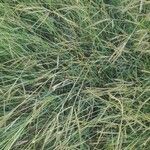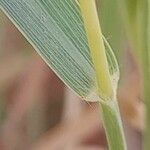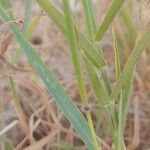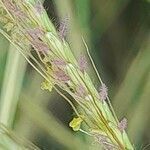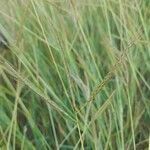Densely tufted perennial, up to 1 m tall, nodes with a ring of spreading hairs. Leaves linear-lanceolate, ligule membranous. Inflorescence of 2-many digitate or subdigitate racemes (30-)60-80 mm long, spikelets paired in a sessile and pedicellate combination of dissimilar spikelets. Sessile spikelets 2.5-5 mm long, with long hairs, dorsiventrally compressed; lower glume obtuse to truncate, subapical fringe of long hairs present; lemma awn 8-25 mm long, curved, column (basal part of awn) twisted. Pedicellate spikelets awnless.
Perennial; culms 25–100 cm. high, geniculately ascending.. Leaf-blades 3–30 cm. long, 2–7 mm. wide.. Inflorescence composed of (1–)2–15 subdigitate shortly pedunculate racemes, the peduncles glabrous; racemes 3–7 cm. long, the spikelets subimbricate with 0–6 smaller homogamous pairs at the base.. Sessile spikelet narrowly oblong, 2–6 mm. long; lower glume firmly cartilaginous, slightly concave, pubescent to villous below the middle, with long bulbous-based hairs above, obtuse to subacute; awn 8–25 mm. long.
Sessile spikelets 2–6 mm long, oblanceolate; inferior glume slightly concave, pubescent below the middle, with long tubercle-based cilia above; superior glume slightly shorter than the inferior, glabrous except for the often shortly ciliate keel and apex; inferior floret barren, the lemma c. 3.8 mm long, ovate, hyaline; superior floret stipitiform, the lemma c. 3 mm long; awn c. 25 mm long, minutely hispidulous on both column and bristle; anthers c. 1.5 mm long.
Caespitose, decumbent or erect perennial with distinct short rhizomes; culms up to 200 cm high, woody and persistent, robust, geniculately ascending, simple or branched; nodes exposed and densely barbate; internodes glabrous; leaf sheaths glabrous or sparsely pilose; ligule a glabrous membrane c. 2 mm long; leaf laminas up to 30 cm × 4–4.5 mm, linear-lanceolate, glabrous for most of their length but long-pilose near the ligule.
A grass which keeps growing from year to year. It forms erect tussocks. It grows 0.5-1 m high. The leaves are 10-30 cm long and 0.3-0.5 cm wide. The culms are erect and branched. They are slender and covered with white powder. The seed heads can be single or in groups or 2-4. They are 4-6 cm long. They are pale green or purple.
Racemes 2–many, subdigitate, shortly pedunculate, the peduncles glabrous; rhachis internodes and pedicels pilose, sometimes on one side only; the lowermost 1–6 spikelet pairs usually homogamous, male or neuter.
Pedicelled spikelets similar to the sessile spikelets in size and shape, often slightly smaller, male or neuter.
Tufted perennial up to 1 m. high.
